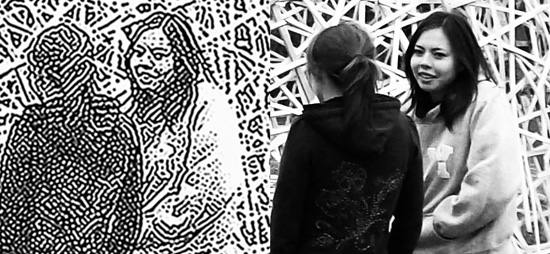Harriss: Mathematical Sculpture
Strange appearance in the North Atlantic:
Here’s a puzzle that sounds a little like those, “A train leaves…” questions we were all prepared for but rarely saw on the SAT, but with a twist.
You are going to take a drive from City A to City B and back, but in a rather unusual car. When travelling uphill, the car always moves at exactly 56 miles per hour. On level ground, it travels at 63 miles per hour and finally when travelling downhill it travels at 72 miles per hour. Assume that it transitions from one speed to another instantaneously and all of those other “mathematically perfect” qualities that make questions like this answerable.
You find that travelling from City A to City B takes exactly 4 hours of travel time. On the return trip, driving time sums to 4 hours and 40 minutes.
How far apart are Cities A and B?
Here’s an old puzzle, I think from Martin Gardner though I can’t immediately find a reference, adapted as a fun trick for spring break — if you have just the right sort of friends.
Invite a friend to invent a polynomial of any order, but require that it have only positive integer coefficients. Next, you explain that you have to get something of a feel for the polynomial so you provide an integer and ask them to apply the polynomial to it, telling you the value. You may have to do this more than once. You then close your eyes and dramatically tell them what their polynomial is.
What strategy would you use and how many values would you have to provide?
There has been a theme in some of the recent posts and problems. It’s a little buried but almost enough to say its another of those Mathfactor agendas when we try to sneak some knowledge to you buried in the fun. Never one to miss such an opportunity I will jump in with a post, and a problem. This is a slight change to a classic problem that comes out of the work of one of my mathematical heroes: Leonardo of Pisa, also known as Fibonacci. He is responsible for changing how we count! Not many people can claim that. He introduced the system base value, also known as Arabic numerals that we still use today into Europe. He is more famous however for talking about rabbits:
Imagine that you have immortal rabbits, Bugs Bunny’s version of Olympus perhaps. Even if they are immortal however rabbits are famous for one thing. They breed like, well rabbits. Some of the rabbits are children and some adults and are divided into pairs. Each month any child pairs become adults and any adult pairs breed to produce a new child pair. They are immortal so no pair ever dies. These rabbits are also a little odd. They live on a line (don’t complain, this is no more ludicrous than that they are immortal!), but can shuffle along. Also if you are worried about inbreeding, the male rabbit leave the family hutch and shuffle along the line past others until they find a suitably unrelated mate. Why we would be worried about inbreeding in immortal rabbits living on a line escapes me!
Anyway we start with one pair of children. Lets put a c. After a month they become adults, a. Another month passes and they now have a pair of children, but are still there themselves. We therfore have the original pair and a pair of children: ac. Next month the adults have another pair of children and the children become adults: aca. Can you see how this will work? Each month the children become adults so we replace every c with and a, each pair of adults has a new pair of children but stays as adults, so we replace every a with ac. We can continue to get longer and longer sequences of rabbits on this line:
aca to acaac to acaacaca to acaacacaacaac….
Now some puzzles. Given a line with 21 adult pairs and 13 child pairs, how many pairs of adults and children would there be after one month?
Given p adults and q children how many adults and children will there be after one month?
Finally a more difficult one. How will the ratio of adults to children behave month on month? Will it
a) Get closer and closer to a particular number?
b) Keep on changing without pattern?
In either case can you say more?
You have a sack of coins of three types: brass, silver and gold. You know that the majority of the coins are gold, though they’ve been painted and partially hollowed so that you can’t actually determine the type of a particular coin. Fortunately, you have a machine into which you can insert two coins and the machine will tell you whether the two coins are of the same type or different types.
Your task is to locate a gold coin.
You will compare the coins in “passes” with each coin not being compared more than once in a pass. In a pass, every coin can be a member of a comparison or not, but any particular coin can’t be part of more than one comparison during the pass. Your goal is to minimize the number of passes required to be sure that you locate a single gold coin.
You should be able to describe how many passes (at most) your solution will require rather than the number of passes increasing arbitrarily with the number of coins that turn out to be in the bag.

On April 29, 2004, we did a piece on the very first Bamboopalooza; (the segment BG. Bamboopalooza was a couple of years later) and Jenn Starr asks about the sequence 1 3 7 12 18 26 35 …
(Incidentally, once you unlock the secret of the sequence, can you determine how fast, asymptotically, it will grow?)
Is it true that if you give me any number you please (say 3, for example), I can come up with a new number (in this case 3/2) so that the sum and products of our numbers are the same? ( 3+ 3/2 = 3 x 3/2 = 9/2 )
A couple more examples: if you give me 0, I’ll give you 0, and 0+0 = 0 x 0.
If you give me 2, I’ll give you 2 and 2 + 2 = 2 x 2.
If you give me -1, I’ll give you 1/2 since -1 + 1/2 = -1 x 1/2.
Can I always give a response to your number, or is there a way to stump me?
Here’s a quick puzzle that I don’t think has appeared here previously.
A man leaves at exactly 6:00 AM to climb a mountain. He may not climb at a constant rate. In fact, he may stop to rest, or even backtrack a bit to see something interesting. He arrives at the summit at exactly 6:00 PM and camps for the night.
The next day, he starts down at exactly 6:00 AM, again meandering unevenly, but following exactly the same path and reaching the bottom at exactly 6:00 PM.
The question is, was there some point on the path he was sure to have visited at exactly the same time on the two trips?
I have just published a (rather long) article on mathematical surfaces, their models and links to art over at Maxwell’s Demon. Here is a sneak preview.
We usually pose puzzles, which implies we know the answer ahead of time. But today I’m stumped, and have a real question I hope someone out there can answer.

It’s really quite amusing to repeatedly apply a series of effects to an image, say using Photoshop filters. I didn’t think about it until yesterday, but this is a great way to model various kinds of things, particularly certain partial differential equations.
To take a really simple example, we all know that heat diffuses, and that in the absence of any energy being pumped into a system, temperatures will tend to even out over time. Similarly, if we apply a blur to an image over and over again, soon we will have a smeared out gray.
Heat is modeled in a continuous realm: time is continuous, space is continuous. But while blurring, time occurs in discrete steps, and space is modeled in discrete pixels. Nonetheless, the two phenomena are closely related.
The famous heat equation is very simple:
du/dt ∝ Δu
All this means is that the amount of a quantity ‘u’ in a given location changes over time, and this change is proportional to how much net variation there is nearby– the more variation the more u will change. (For those with more than Cal III under your belt, no need to explain; if you’ve had Cal I, if we measure temperature along a rod, then this Δu works out to be just d2u/dt2 and sure– the more concave up the function is, say, the faster the heat will increase at that spot, in an attempt to smooth out the temperature; if you haven’t had any calculus, or even if you have, it’s interesting to consider a discrete version of this:
Suppose we have a bunch of graph paper, with a temperature written in every cell. Then the new temperature at each new time can be modeled by taking a weighted average of the neighbors. For example, if we’re at X :
a b c
d X f
g h i
we might take an average using none of a,c,g and i, 1/8 of b,d,f,h and 1/2 of our original value X. (Generally we count closer spots more)
i.e. new value = X/2 + (b+d+f+h)/8
The change from the old value to the new value is —X/2 + (b+d+f+h)/8, and sure enough this is a discrete form of the laplacian.
We used photoshop to make the image at left , at the top of this post: we’ve applied a gaussian blur (rad = 1 px) and then three sharpens, and then repeated this over and over again.
And look!! Unmistakably, the spots and stripes that are the hallmarks of reaction diffusion types of equations have popped up!!
Reaction diffusion patterns pop up in many places– not least of which in the patterns of spots or stripes on many living things. The idea in reaction diffusion is that one or more quantities (like the amount of black in a pixel, or the amounts of various hormones or chemicals) simultaneously diffuse (blur) and react (changing the concentrations). These two actions are in a kind of tug-of-war, and when they are well-matched all kinds of interesting things can occur.
Here’s my question (for experts only): that doesn’t make sense– aren’t both a gaussian blur and sharpening modeled by adding / subtracting a laplacian? And where is the reactive term?
Incidentally, here’s another example that works beautifully:
If we repeatedly apply a gaussian blur and heighten the contrast, we obtain a sequence of images as below
This is exactly what we should expect: this is a discrete form of a well-known reaction diffusion equation in which the reactive force drives the interface between black and white towards having less and less total curvature.
—-
Incidentally, the discoverer of this class of equations was none other than the great Alan Turing, father of the theory of computation (and, as it happens, leader of the effort to crack the Nazi enigma code). I must take the opportunity to remind us all again that this great man was hounded to his suicide for his homosexuality by the very government he’d worked to save— a clear a martyr to the cause of universal human rights as there can be.